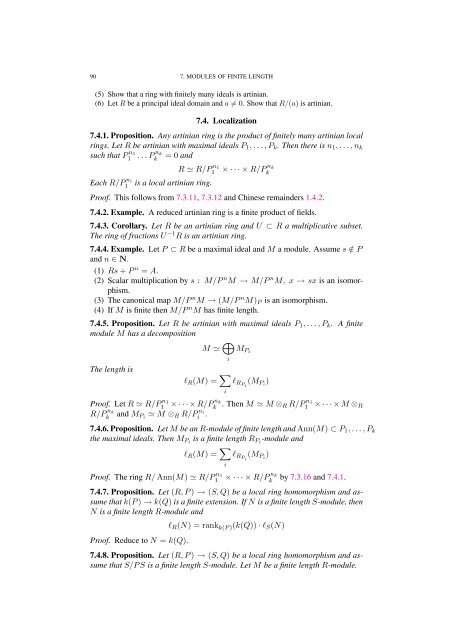Commutative algebra - Department of Mathematical Sciences - old ...
Commutative algebra - Department of Mathematical Sciences - old ...
Commutative algebra - Department of Mathematical Sciences - old ...
You also want an ePaper? Increase the reach of your titles
YUMPU automatically turns print PDFs into web optimized ePapers that Google loves.
90 7. MODULES OF FINITE LENGTH<br />
(5) Show that a ring with finitely many ideals is artinian.<br />
(6) Let R be a principal ideal domain and a = 0. Show that R/(a) is artinian.<br />
7.4. Localization<br />
7.4.1. Proposition. Any artinian ring is the product <strong>of</strong> finitely many artinian local<br />
rings. Let R be artinian with maximal ideals P1, . . . , Pk. Then there is n1, . . . , nk<br />
such that P n1<br />
1 . . . P nk<br />
k = 0 and<br />
R R/P n1<br />
nk<br />
1 × · · · × R/Pk Each R/P ni<br />
1 is a local artinian ring.<br />
Pro<strong>of</strong>. This follows from 7.3.11, 7.3.12 and Chinese remainders 1.4.2.<br />
7.4.2. Example. A reduced artinian ring is a finite product <strong>of</strong> fields.<br />
7.4.3. Corollary. Let R be an artinian ring and U ⊂ R a multiplicative subset.<br />
The ring <strong>of</strong> fractions U −1 R is an artinian ring.<br />
7.4.4. Example. Let P ⊂ R be a maximal ideal and M a module. Assume s /∈ P<br />
and n ∈ N.<br />
(1) Rs + P n = A.<br />
(2) Scalar multiplication by s : M/P n M → M/P n M, x → sx is an isomorphism.<br />
(3) The canonical map M/P n M → (M/P n M)P is an isomorphism.<br />
(4) If M is finite then M/P n M has finite length.<br />
7.4.5. Proposition. Let R be artinian with maximal ideals P1, . . . , Pk. A finite<br />
module M has a decomposition<br />
M <br />
The length is<br />
Pro<strong>of</strong>. Let R R/P n1<br />
ℓR(M) = <br />
R/P nk<br />
k and MPi M ⊗R R/P ni<br />
i .<br />
1<br />
i<br />
i<br />
MPi<br />
ℓRP i (MPi )<br />
nk<br />
× · · · × R/Pk . Then M M ⊗R R/P n1<br />
1 × · · · × M ⊗R<br />
7.4.6. Proposition. Let M be an R-module <strong>of</strong> finite length and Ann(M) ⊂ P1, . . . , Pk<br />
the maximal ideals. Then MPi is a finite length RPi-module and<br />
ℓR(M) = <br />
ℓRP (MPi i )<br />
Pro<strong>of</strong>. The ring R/ Ann(M) R/P n1<br />
1<br />
i<br />
× · · · × R/P nk<br />
k<br />
by 7.3.16 and 7.4.1.<br />
7.4.7. Proposition. Let (R, P ) → (S, Q) be a local ring homomorphism and assume<br />
that k(P ) → k(Q) is a finite extension. If N is a finite length S-module, then<br />
N is a finite length R-module and<br />
Pro<strong>of</strong>. Reduce to N = k(Q).<br />
ℓR(N) = rank k(P )(k(Q)) · ℓS(N)<br />
7.4.8. Proposition. Let (R, P ) → (S, Q) be a local ring homomorphism and assume<br />
that S/P S is a finite length S-module. Let M be a finite length R-module.
















